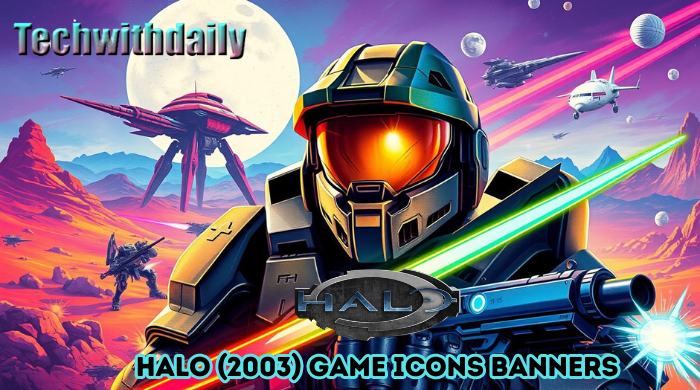Introduction to Game Icons
In the vibrant world of gaming, icons are more than just visuals; they’re symbols that resonate with players and evoke memories. They encapsulate the essence of a game, instantly transporting fans to expansive universes filled with adventure and excitement. One iconic title that has left an indelible mark on this landscape is Halo: Combat Evolved, released in 2001. As we delve into the evolution of Halo’s game icons from its inception through 2003 and beyond, we’ll uncover how these visual elements have shaped not only player experiences but also the entire gaming industry. Join us as we explore the Halo (2003) game icon banners that revolutionized gameplay aesthetics and their lasting impact on fans around the globe.
halo (2003) game icons banners
The “Halo (2003) game icons banners” represent a pivotal moment in gaming history. As the franchise gained momentum, these visuals became synonymous with epic battles and immersive storytelling.
Each banner crafted for Halo exuded a distinct aesthetic, showcasing iconic characters and vivid landscapes. They served not just as promotional material but as an invitation to players into a rich universe filled with lore.
These game icons encapsulated the essence of what made Halo special—the blend of sci-fi elements and deep-rooted themes of heroism and sacrifice. Fans eagerly anticipated each release, often sharing their favorite designs across platforms.
As technology evolved, so did the complexity and detail within these graphics. They transformed from simple images into intricate works of art that resonate with gamers worldwide today, solidifying Halo’s place in pop culture.
Impact on the Gaming Industry
![]()
The arrival of Halo: Combat Evolved marked a pivotal moment in gaming history. It wasn’t just the gameplay that captivated players; it was the iconic imagery associated with it. The game icons and banners created for Halo became symbols of modern gaming culture.
These visuals had a profound impact on marketing strategies within the industry. Game developers began to realize how powerful strong visual branding could be in attracting an audience. Halo set new standards for design, making game icons integral to a franchise’s identity.
Moreover, these elements fostered community engagement. Fans rallied around memorable graphics, sharing them across various platforms and creating a sense of belonging among players. This shift encouraged other franchises to invest heavily in distinctive iconography, sparking creativity throughout the gaming landscape.
Halo’s influence can still be felt today as newer titles strive to create legendary icons that resonate with gamers worldwide.
Evolution of Halo’s Game Icons and Banners
Halo’s game icons and banners have undergone remarkable transformations since the franchise began. The original designs were simple yet iconic, encapsulating the essence of Master Chief and his epic battles.
As technology advanced, so did the artistry behind these visual elements. Early versions featured basic graphics but quickly evolved into intricate designs that showcased stunning visuals and deeper storytelling.
The introduction of Halo (2003) game icons banners vibrant colors and dynamic compositions in later releases reflected not just technological progress but also a growing fanbase eager for more immersive experiences. Each new installment brought fresh interpretations, blending nostalgia with modern aesthetics.
These evolving icons became symbols of loyalty among fans, creating an emotional connection to the franchise. With each iteration, they captured not only gameplay dynamics but also thematic depths that resonated across generations.
Analysis of Changes in Design and Representation
![]()
The design of game icons has undergone significant shifts since the early 2000s. Initially, Halo’s graphics embraced a more simplistic and bold aesthetic. The iconic Spartan helmet became synonymous with the franchise.
As technology advanced, so did the complexity of these designs. Subsequent games introduced richer textures and dynamic elements that brought characters to life in ways previously unseen. This evolution reflects not only technological progress but also changing player expectations.
Representation of in-game icons has expanded too. Early designs focused heavily on military motifs and action-oriented imagery. Modern iterations now encompass diverse character portrayals, appealing to a broader audience while fostering deeper emotional connections.
These changes signify an understanding of gamers’ desires for authenticity and relatability within their gaming experiences. Every redesigned icon tells a story, drawing players into immersive worlds that resonate on multiple levels.
The Role of Game Icons in Attracting Players
Game icons serve as the visual heartbeat of a title. They encapsulate the essence of gameplay, evoking curiosity and excitement.
A well-designed icon can draw players in, sparking interest long before they hit ‘play.’ It’s often the first impression that shapes expectations.
In an industry flooded with options, distinct icons help games stand out among competitors. Colors, shapes, and symbols communicate themes instantly.
Moreover, these images create emotional connections. Fans may associate game icons with memorable moments or beloved characters. This nostalgia fosters loyalty within gaming communities.
Engaging banners featuring iconic artwork amplify this effect further by showcasing aesthetics and immersing potential players in a world they want to explore. The right visuals not only attract but also resonate deeply with audiences across diverse platforms.
As players navigate their choices, striking game icons become essential tools for developers aiming to captivate new gamers while retaining loyal fans.
Future Possibilities and Innovations in Game Icon Design
As the gaming landscape evolves, so too do the possibilities for game icon design. The advent of augmented reality (AR) and virtual reality (VR) presents exciting opportunities. Imagine icons that adapt dynamically to player actions or environmental changes within a game.
Interactive elements could become commonplace. Icons may not just serve as static images but act as intuitive tools guiding players through intricate worlds. This shift would enhance immersion and engagement.
Additionally, AI-driven designs are on the horizon. Algorithms could analyze player preferences and tailor icons to individual tastes, creating a personalized experience like never before.
Sustainability might also play a role in future designs. Eco-conscious gamers might gravitate towards brands that prioritize environmentally friendly materials and practices in their merchandise, including game icons.
The integration of blockchain technology could introduce unique NFTs associated with iconic imagery, adding value beyond mere aesthetics while fostering community ownership among fans.
Conclusion
![]()
Game icons have become more than just visual elements; they are a vital part of gaming culture. The evolution of these icons reflects the changing landscape of player expectations and technological advancements.
Halo’s game icons and banners Halo’s (2003) game icon banners illustrate this transformation beautifully. Each design choice resonates with fans, creating connections that go beyond gameplay.
As we look ahead, innovation in iconography will continue to shape how players engage with games. New trends will emerge, driven by community feedback and artistic exploration.
There’s an undeniable excitement about what lies on the horizon for game icon design. The journey is far from over, promising new experiences for players eager to connect with their favorite titles in fresh ways.
Introduction to Game Icons and their importance in the gaming industry
Game icons serve as the visual language of the gaming world. They encapsulate a game’s essence, making it instantly recognizable to players. These symbols can evoke nostalgia and excitement, creating an emotional connection with gamers.
In today’s digital landscape, where attention spans are fleeting, impactful design is crucial. A compelling icon can draw players in and spark curiosity about a game they may not have considered otherwise.
Beyond aesthetics, game icons also represent branding strategies. Companies invest heavily in their development to ensure consistency across platforms and merchandise. This helps build brand loyalty among fans.
With millions of games available, effective icons cut through the noise. They provide a quick way for gamers to identify titles that resonate with their preferences and interests—making them vital assets in the competitive industry landscape.
The Arrival of Halo: Combat Evolved in 2001
When Halo: Combat Evolved launched in 2001, it marked a pivotal moment in gaming history. The game introduced players to the expansive universe of Master Chief and the Covenant. Its engaging storyline captivated audiences.
Halo redefined first-person shooters with its innovative mechanics. The multiplayer mode brought friends together like never before. Players could combat each other on various maps, creating memorable experiences that still resonate today.
The graphics were groundbreaking for its time, featuring lush environments and detailed character models. This visual fidelity transported gamers into an immersive world where they felt part of the action.
Additionally, Halo’s soundtrack added depth to the gameplay. Martin O’Donnell’s iconic score enhanced emotional connections to characters and events throughout the campaign.
From its release, Halo established itself as a cornerstone of Xbox culture and laid the foundation for future titles in the franchise.
How Halo’s game icons and banners revolutionized the gaming world
Halo’s game icons and banners marked a turning point in the gaming industry. They introduced a new level of artistry that combined compelling visuals with deep thematic elements.
The iconic Master Chief silhouette became instantly recognizable. It wasn’t just about branding; it represented an entire universe, sparking curiosity among potential players.
Banners for Halo didn’t merely advertise the game; they told stories. Each design evoked emotions, drawing gamers into its epic narrative before they even picked up the controller.
This innovative approach to visual representation set new standards across the industry. Competitors began to realize that effective marketing could be as vital as gameplay mechanics themselves.
Incorporating cinematic quality into promotional materials also paved the way for future franchises to elevate their designs, reshaping how games were marketed worldwide.
Evolution of Halo’s game icons and banners from 2003 to present day
![]()
Since its launch, Halo has consistently redefined its visual identity. The game icons and banners from 2003 showcased a sleek, futuristic design that mirrored the series’ cutting-edge gameplay.
Over the years, these graphics evolved to reflect advancements in technology and player expectations. From simple emblematic designs to intricate artwork featuring beloved characters like Master Chief and Cortana, each iteration added depth to the franchise’s narrative.
The inclusion of vibrant colors and dynamic backgrounds not only caught players’ eyes but also enhanced their connection with the game’s universe. As new titles emerged, so did fresh concepts for branding.
This evolution illustrates how Halo’s (2003) game icon banners Halo adapt while remaining rooted in its core themes. By continually innovating in design elements, it manages to attract both old fans and newcomers alike. Each update invites players into an ever-expanding world filled with rich stories and unforgettable moments.
Impact of Halo’s game icons on the franchise’s success and fanbase
Halo’s game icons have played a crucial role in shaping the franchise’s identity. From the moment players laid eyes on the iconic Master Chief helmet, they recognized something extraordinary.
The graphics of Halo (2003) elevated expectations for visual storytelling in games. It wasn’t just about gameplay; it was also about immersion through powerful imagery. The banners created a sense of epic adventure that pulled fans into its universe.
Moreover, these visuals fostered community bonding. Players shared their love for Halo through fan art and merchandise showcasing those memorable icons. This connection transformed casual gamers into devoted enthusiasts.
As each sequel rolled out, the consistency and evolution of these designs kept fans engaged. They felt part of an ongoing story where every new icon added depth to their experience while reinforcing brand loyalty across generations.
halo (2003) game icons banners
The “Halo (2003) game icons banners” represent a pivotal moment in gaming history. These visual elements were more than just graphics; they encapsulated the essence of an expansive universe filled with epic battles and memorable characters.
Each banner told a story, drawing players into the rich lore of Master Chief and his fight against the Covenant. The iconic green armor became synonymous with heroism, while alien designs added intrigue.
In this era, game icons started shifting from mere functional symbols to vital components of brand identity. They created instant recognition, fostering loyalty among fans who proudly displayed these visuals on their consoles and merchandise.
With cutting-edge design techniques emerging at that time, Halo’s banners showcased how aesthetics could enhance player engagement. This strategy set new standards for future titles aiming to captivate gamers visually while establishing strong franchise identities.
The future of game icons in the ever-changing gaming
The future of game icons is Halo (2003) ![]() game icon banners brimming with potential. As technology advances, we can expect to see even more innovative designs that resonate with players on a deeper level. The rise of virtual reality and augmented reality will influence how icons are created and perceived, making them more immersive.
game icon banners brimming with potential. As technology advances, we can expect to see even more innovative designs that resonate with players on a deeper level. The rise of virtual reality and augmented reality will influence how icons are created and perceived, making them more immersive.
Interactive elements may become commonplace, allowing users to engage with icons in new ways. Imagine tapping an icon to reveal backstories or unlock exclusive content—an exciting prospect for gamers.
With the growing emphasis on inclusivity in gaming, future game icons might reflect diverse characters and stories. This shift could help broaden the appeal of games while fostering stronger connections within communities.
As trends change and player preferences evolve, so too will the design philosophies behind these essential visual elements. Game developers have an opportunity to push boundaries further than ever before. The evolution of “Halo (2003) game icon banners” serves as a pivotal example—a blend of creativity and strategy that captures attention across generations.
In this vibrant landscape, one thing remains clear: the role of game icons will only grow more significant as they continue shaping experiences for players worldwide.



